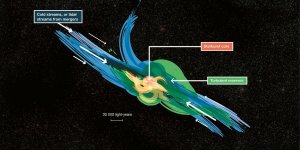| News / Space News |
Mars Has Metal in Its Atmosphere
Mars has electrically charged metal atoms (ions) high in its atmosphere, according to new results from NASA's MAVEN spacecraft. The metal ions can reveal previously invisible activity in the mysterious electrically charged upper atmosphere (ionosphere) of Mars.

Mars has metal in its atmosphere. ![]()
"MAVEN has made the first direct detection of the permanent presence of metal ions in the ionosphere of a planet other than Earth," said Joseph Grebowsky of NASA's Goddard Space Flight Center in Greenbelt, Maryland.
Because metallic ions have long lifetimes and are transported far from their region of origin by neutral winds and electric fields, they can be used to infer motion in the ionosphere, similar to the way we use a lofted leaf to reveal which way the wind is blowing.
MAVEN (Mars Atmosphere and Volatile Evolution Mission) is exploring the Martian upper atmosphere to understand how the planet lost most of its air, transforming from a world that could have supported life billions of years ago into a cold desert planet today.
Understanding ionospheric activity is shedding light on how the Martian atmosphere is being lost to space, according to the team. (Tasnim News Agency)
YOU MAY ALSO LIKE



